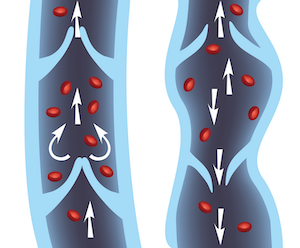Venous Insufficiency
The veins that carry blood from our legs to the heart have one-way valves, which exemplify this function by allowing the blood to go upstream towards the heart but not downstream back to the foot. It may occur due to a past blood clot in the legs. When these valves become damaged, a consultation with a venous insufficiency specialist is crucial.
If these valves fail, blood pools in the legs, causing congestion and chronic venous insufficiency. Seeking early diagnosis and care from a venous insufficiency treatment doctor can significantly reduce the risk of long-term damage. Venous insufficiency is progressive, so seeking treatment as soon as symptoms arise is essential.
Venous Insufficiency Specialist Doctor
If you are facing any kind of Venous Insufficiency problem, you should immediately consult a Venous Insufficiency Doctor. These specialists are trained to diagnose & treat the underlying causes of venous insufficiency using advanced techniques tailored to the severity of the condition. In some cases, conservative treatments such as lifestyle changes, compression therapy, or medications are effective. However, in more advanced stages, the doctor may recommend venous insufficiency surgery to repair or remove damaged veins.

Chronic Venous Insufficiency Symptoms
- Leg ulcers.
- Swelling of the legs.
- Hyper pigmentation or discoloration of the legs.
- Eczema.
- Chronic infection inflammation pain while walking.
- Lower extremity varicosities.
Causes of Chronic Intravenous Insufficiency
- History of deep venous thrombosis in the legs which destroys the one-way valve history of pregnancy obesity prolonged standing.
- Prolonged sitting with legs crossed.
- Wearing tight undergarments or clothing.
- Hormonal change family.
- History injury to the veins.
Chronic Venous Insufficiency Treatments
Treatment for chronic venous insufficiency includes compression stockings and compression devices with intermittent pneumatic compression. Patients also get symptomatic relief from leg elevation. A venous insufficiency specialist will often recommend such conservative treatments initially.
Venous Insufficiency Surgery
For patients with severe or chronic venous insufficiency, venous insufficiency surgery is often a long-term solution that can prevent further complications such as leg ulcers or blood clots. By consulting a venous insufficiency specialist, you can explore options such as sclerotherapy, radiofrequency ablation, or more invasive surgeries, depending on your condition’s severity. Early intervention by a venous doctor ensures that the condition is managed effectively, preventing the need for more aggressive treatments. Depending on individual needs, surgical treatments like ligation and stripping, microincision/ambulatory phlebectomy, Subfascial Endoscopic Perforator Surgery (SEPS), and vein bypass are also considered.
Ligation and Stripping: This procedure involves tying off (ligation) and removing (stripping) damaged veins, preventing blood from pooling and improving circulation.
Microincision/Ambulatory Phlebectomy: A minimally invasive surgery where small incisions remove varicose veins close to the skin’s surface.
Subfascial Endoscopic Perforator Surgery (SEPS): This endoscopic procedure targets perforator veins, reducing pressure on the superficial veins and preventing further complications.
Vein Bypass: In severe cases, a healthy vein bypasses a blocked or damaged vein, allowing for improved blood flow.
Proudly accepting patients in